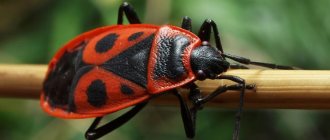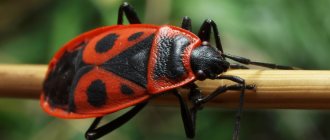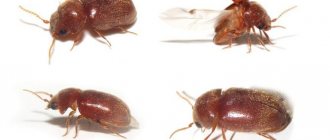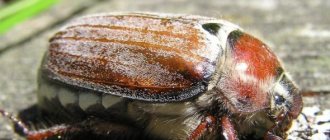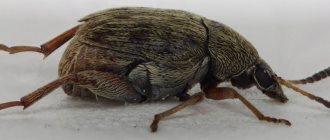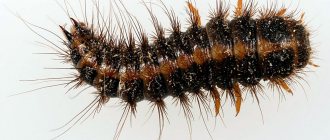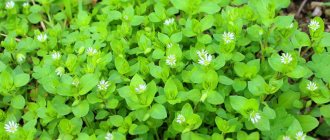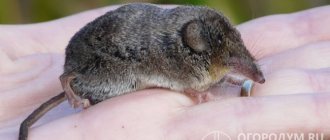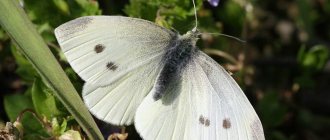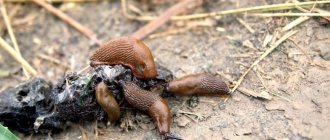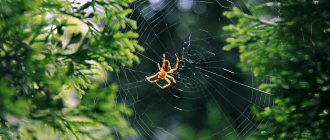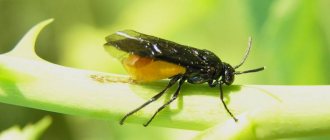Many people admire insects, not at all suspecting that some of them cause enormous damage to agricultural crops. In total, there are about 760 thousand species of various insects on Earth, among which there are more than 300 thousand beetles.
The order of beetles is divided into 3 suborders - ancient beetles, carnivorous and heterovorous. The first, richly represented in the past, contains only a few dozen species existing today, but it is also the source for the other two. Among such diversity, red beetles with black dots and, conversely, black beetles with red spots stand out against the background of greenery.
The article provides information about the more common and frequently encountered ones.
General information about beetles
Before we find out what red beetles with black dots are called, we will find out what insects are - beetles.
These are the most diverse and numerous types of insects, living in almost all areas of land and water - in the tundra, deserts, mountains, forests, fresh water bodies, and even in human habitation.
Beetles differ greatly from each other in appearance and size. Some are so tiny that they cannot be seen, others, for example, like the goliath beetle, can reach 15 centimeters in length.
Lifestyle, nutrition
The squeak beetle is active in the warm season - from May to August. The mating season begins at the end of spring, larvae begin to appear in June, and by the end of August a new generation of young adults emerges. The lily beetle lives in numerous colonies and prefers lilies of different varieties. When there is a lack of food, it settles on hazel grouse, lilies of the valley, and weeds.
Lily beetle
It is active during the day and sits motionless on plants at night. The larvae live on the underside of leaves, hiding from direct sunlight. Some species of birds feed on adult beetles. The main enemies for the larvae are ground wasps.
The red lily beetle pest lives for several seasons. With the onset of cold weather, young individuals burrow into the ground, tolerate frosty winters well, crawl to the surface in the spring, begin to mate, and lay eggs. By the end of August they die, leaving the young generation, the pupae, to overwinter.
What do soldier bugs eat is of interest to gardeners. You need to know whether it is worth fighting and how to react to it.
The soldier bug has a piercing-sucking apparatus. It feeds on plant juices. It pierces the leaf plate and draws out juices with its proboscis. You can notice it on any garden or vegetable crop; it settles on weeds.
It is the peculiarities of nutrition that make a person think about the benefits and harms of a soldier. Insects live in colonies, which unites them with harmful turtles; there is a high probability of pests on a large scale.
Structural features of beetles
The red beetle with black dots on its wings (shown in the photo below), like all other varieties of beetles, has its own structural features. The main distinguishing feature of beetles is their strong and rigid fore wings (or elytra), which when folded form a chitinous shell that protects the thinner second pair of wings - membranous.
There are so many creatures in the world who want to dine on bugs that others had to acquire such hard chitinous armor to protect their bodies. Like all insects, beetles have a head, thorax (abdomen) and thorax. Their jaws (three pairs in total) are extremely powerful and durable. Most beetles have good eyesight, but they rely mainly on their sensory organs of touch, the antennae located on the sides of their heads.
The heart is located inside the abdomen, and it is protected by a strong chest plate (pronotum). The abdomen also contains the intestinal tract, stomach and the entire respiratory system.
Many beetles have two pairs of wings, of which the lower ones are used for flight, hidden in a sitting position under the chitinous elytra. Before taking off, the beetle raises its elytra, and only then spreads its delicate, thin wings.
In total, like other insects, the beetle has 6 legs attached to the thoracic region of the body.
Appearance
Description of the soldier, external characteristics, body structure features:
- The bright color of the soldier bug, as well as its collective lifestyle, makes it noticeable to others. The color type of the wingless red bug is unique. The oblong body is bright red. There are black patterns all over the surface.
- Body size is about 10 mm. There are elytra on the back, but no wing liners. The red bug does not fly, but crawls very quickly. Three pairs of legs have sharp claws, which allow the beetle to move on any surface in a horizontal or vertical position.
- There are small antennae on the head that help the bug beetle navigate in space and find a food source.
The red bug has odorous glands that are activated during times of danger, mating season, and when a food source is found. Therefore, these representatives are often called stink bugs.
The soldier bug in the photo is located below. You can examine in detail the structure of the body, the pattern on the shell. Externally, the bug is attractive and funny. Children fearlessly pick up an interesting creature. Even a cluster of insects does not cause disgust, unlike other types of bedbugs.
Redbug wingless
Ladybugs family
Even small children are familiar with these cute little bugs. They are well known for their lack of fear of humans and their bright red coloration.
The best known is the seven-spotted ladybug (a red beetle with black dots), although their species diversity is enormous.
In total, there are 5,200 species in the world in the family Ladybugs, in the order Coleoptera. This means that their relatives are numerous species of beetles. Some individuals are red with black dots, others have irregularly shaped spots instead of dots, and others are black with red spots. Very rare, but there are ladybugs of the same color, with a black color.
Prevention measures
It is enough to follow a number of rules to prevent the invasion of soldier beetles in your garden or summer cottage. For example:
- Soldier beetles love legumes and alfalfa, so it is better to plant them in a separate area.
- Alfalfa and weeds must be mowed so that no stems remain (at the root).
- It is better to burn the remaining weeds, if any.
- Do not allow rotting wood to remain on the site.
- It is better to treat the trunks of fruit and berry crops with lime, and dig up the root zone well.
- You should not get carried away with excessive fertilization of the soil on the site.
The soldier beetle is not a common pest, but under certain conditions, it can harm the future harvest. Bed bugs attack young shoots and plants more, so it is advisable to take a number of actions to prevent these pests, and others, from appearing on the site. There are pests that cause much more serious damage. In any case, it is necessary to take care of the future harvest, since a lot of work is put into it.
https://youtube.com/watch?v=YC-dQz7A2LY%3Frel%3D0
Description of the ladybug
These are small red beetles with black dots (photo can be seen below) with a rounded, convex body. The lower part of their body is completely flat. Their usual coloring is red, black and yellow in contrasting tones. The head is small. The legs are short, thin, and black. Body length is 5-8 mm.
In sunny weather, these heat-loving insects are active: they crawl hastily, quickly take off and land on plants again in search of food. Their flight is very easy, fast and silent.
Typically, the victims of ladybugs are sedentary insects, and therefore hunting for them involves only eating the victim.
Chemicals against skin beetle
Powdered boric acid or Borax treatment. The same drugs, in bags, are laid out between clothes on shelves for 4 hours, placed in pockets. It is useful to add "Tetrix" or "Executioner". Then the things should be washed and dried.
From aerosols they are treated with “Dichlorvos”, “Difox” or other spraying agents, applying after 1.5-2 weeks.
Anti-moth preparations are used as an additional remedy.
Use a fumigator.
Using Velcro traps or the pharmaceutical product “Parmethrin”.
Distribution, features
Ladybugs are distributed throughout the world. They live on all continents of the world except Antarctica. Ladybugs inhabit open spaces with herbaceous vegetation - gardens, meadows, forest edges, steppes, and less often - forests. They form clusters only during wintering, but otherwise live alone. In search of food, they crawl along the leaves and stems of plants, and can also fly over long distances.
The peculiarity of these beetles is that when threatened, they secrete a rather sharp-smelling, poisonous yellowish liquid that scares away enemies. Only a few species of these beetles are harmful to crops. The rest (predatory species) destroy scale insects, aphids, psyllids and other pests of garden and garden crops.
The ladybug is not always a red beetle with black dots (the photo demonstrates this). Some of the varieties have a yellow outfit with black dots, others are black with red dots. There are even white ladybugs! All of these are young beetles that have recently emerged from the pupa. They acquire their normal adult colors several hours after birth.
Garden pests
We have already written in detail about the pests of each specific garden crop: about the “enemies” of potatoes, cabbage, beets, and parsley. And also about effective methods of combating them.
- All garden pests in tables with descriptions, photos and control measures
We have compiled a “dossier” for you on each pest - save this collection!
But there are also polyphagous garden pests - insects that can damage and destroy plants from different families. Such pest beetles are the most dangerous (we agree that for the sake of brevity, under the conventional name of beneficial and harmful “bugs”, later in the article we will mean all arthropod inhabitants of the garden, specifying their species if necessary).
These are, for example, aphids - cotton and potato. They feed on plant sap, while secreting thick honeydew (honeydew), interfering with the normal functioning of plants. In addition, many of their species are capable of spreading diseases in the form of viruses and promoting the formation of various pathological anomalies (such as galls) in plants.
These are a variety of beetles. For example, the well-known potato, pumpkin and eggplant pests, the Colorado potato beetle. Or the click beetle, which is not dangerous in itself - its wireworm larvae are harmful, devouring the tubers, roots and bases of the stems of many plants. Or kravchik (bighead), which “cuts” the leaves and young shoots of corn, sunflowers and other vegetables.
This is a spider mite that covers the foliage of many vegetable crops with a thin film-web, which prevents the plant from growing and functioning normally.
These are various cutworms, holey leaves, and sometimes stems of tomatoes, onions, cucumbers, potato tubers, carrots and beets.
These are leafhoppers (slobbering pennies) that destroy the leaves and ovaries of almost all garden plants.
These are thrips, whose activity leads to withering of plants and deformation of their fruits.
These are miners that dig oblong tunnels in the leaves of legumes, cucumbers and tomatoes.
These are whiteflies - greenhouse, tobacco, etc. - whose work is visible in the beds in the form of yellowed, spotted, withered, and then fallen leaves.
This is a terrible mole cricket, from which all summer residents groan, watching how a huge insect digs tunnels in the soil in the garden, simultaneously gnawing all the underground parts of the plants encountered along the way.
- How to deal with mole crickets - effective drugs and folk remedies
Don’t know how to get rid of mole crickets on your property? Our recipes will help you protect your garden crops from this underground pest.
Is it true that the above is already enough to seriously concern yourself with the health and safety of your garden?
Of course, harmful insects can be successfully controlled using chemical methods, but this article will discuss another possibility. Let's take a look at the “bright side of the force” and find out how you can save yourself from dangerous “bugs” with the help of their relatives - insect predators and parasites. It turns out that it is often cheaper and more effective.
Varieties
Among the many varieties of ladybugs, there are, as noted above, not only red beetles with black dots, but also black and red in color.
- The four-spotted ladybug is a black beetle with 4 large red spots on the elytra and a body length of up to 6 mm. This is a ubiquitous common species. They destroy colonies of sedentary insects that suck juices from plants: scale insects, scale insects and hermes.
- The two-spotted ladybird is a species that is variable in color. Usually these are beetles with a black pronotum and red elytra, each with a black spot. The body is up to 5 mm long. They destroy (both beetles and larvae) aphids.
- The broad-fronted ladybug is a black beetle with 2 red spots on the elytra. The body is 3 mm long and covered with hairs. Both larvae and beetles feed on scale insects and aphids, and during its full development cycle, one beetle can destroy more than 600 pests.
What harm do bedbugs cause?
When they first meet a soldier, garden owners probably think about the benefits and harms of this insect. The negative impact of bedbugs has a serious impact on agricultural activities.
The damage that beetles cause with their proboscis is expressed in the following:
- spoil the fruits, which then become inedible.
- They destroy crops using the cell sap of shoots for food.
Vineyard owners suffer the most - the soldiers immediately attack the shoots of the crop and the fruits.
This insect is not dangerous for humans. Due to the structure of their proboscis, parasites are not able to pierce human skin.
If a pest crawls along your arm, the only noticeable discomfort will be due to the scratching of its paws on the skin. It is these sensations that people sometimes mistake for the bite of soldier bugs.
If the insect does end up in the room, it is enough to simply get rid of it without additional chemical treatments. As a preventative measure, you can wipe baseboards and wooden furniture with vinegar or kerosene.
Distribution and behavior of toy soldiers
Beetles live in temperate climate zones in Eurasia, and are also found in North Africa and North America. The bug can be seen at almost any time of the year, except winter. There are especially many of them in the spring, when the sun warms up well. They sit in small groups in open areas.
On trees, red beetles with black dots take a liking to old bark. They are also located on loose boards, on bricks, on fences, and even in houses they can be seen in rural areas. In essence, these insects are completely harmless.
The composition of their diet includes fruits that have fallen to the ground, seeds, and plant juice. Their main feature is that they sometimes eat their relatives when they live in large colonies.
At the end of autumn, beetles with red backs and black dots lie down for the winter under fallen leaves, under the bark of trees and in other places sheltered from the wind and severe frosts. With the onset of winter, soldiers enter the adult insect stage. Nature has endowed them with an unpleasant odor to repel natural enemies.
Other organic methods
Two other organic substances that can be used to remove soldier beetles are diatomaceous earth and borax.
Diatomaceous earth is a sedimentary substance made up of tiny fossil materials called diatoms. Soldier insects and other insects that come into contact with it will have their protective coating damaged and eventually die. It is necessary to distribute the product around the perimeter of the house, around trees with larvae and adult pests. You should also treat the area of your yard where bed bugs tend to congregate.
Often used for household cleaning, borax, which is a boron-based compound, destroys the beetles' protective coating and their cell membranes. It is worth treating trees where bedbugs live and the inside of the house's exterior siding with borax.
Two other organic substances that can be used to kill soldier beetles are diatomaceous earth and borax.
If your own home treatments prove ineffective or you lack the proper equipment, calling a professional exterminator may be your best option. He definitely needs to explain the task: to prevent pests from entering the house or to completely exclude them from the yard. The most common method is perimeter treatment.
Shrenk's Blister
Red beetles with black dots also include the Schrenk's blister beetle. He is easily recognizable by his bright, characteristic appearance. Its elytra are red or orange, with transverse stripes and black spots. The body is distinguished by dense hair.
On sunny days, these beetles can be seen sitting one or several individuals on flowers. They are usually slow and lethargic. Their larvae are more mobile than adults. Penetrating into locust egg capsules, they feed on their eggs.
These insects received this name due to the fact that their blood contains poison (cantharidin), which strongly irritates the skin and causes the appearance of water blisters (abscesses). It may also happen that an animal that swallows this beetle with grass will get sick and die.
The carpet beetle bites
The bite of the skin beetle is painful and often dangerous - infection with parasites. For people with sensitive skin it will appear as bright red spots, for others it will appear as small harmless dots. The larvae spread the viral infection wherever they crawl. To get rid of it, you need to clear the room of both the bug and the eggs.
Skin beetle bites are painful for children and women. If a skin beetle has bitten you, use a disinfectant or hydrogen peroxide or alcohol to treat the bite site. An allergic reaction is relieved with an antihistamine. For quick healing, use a moisturizer if there is no infection. If inflammation appears, you should see a doctor.
Prevention measures
It is enough to follow a number of rules to prevent the invasion of soldier beetles in your garden or summer cottage. For example:
- Soldier beetles love legumes and alfalfa, so it is better to plant them in a separate area.
- Alfalfa and weeds must be mowed so that no stems remain (at the root).
- It is better to burn the remaining weeds, if any.
- Do not allow rotting wood to remain on the site.
- It is better to treat the trunks of fruit and berry crops with lime, and dig up the root zone well.
- You should not get carried away with excessive fertilization of the soil on the site.
The soldier beetle is not a common pest, but under certain conditions, it can harm the future harvest. Bed bugs attack young shoots and plants more, so it is advisable to take a number of actions to prevent these pests, and others, from appearing on the site. There are pests that cause much more serious damage. In any case, it is necessary to take care of the future harvest, since a lot of work is put into it.
Soldier bug. In excellent quality. Full HD 1080p
Watch this video on YouTube
